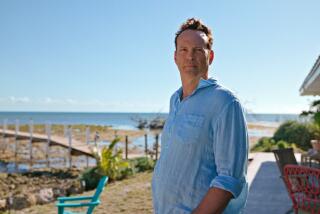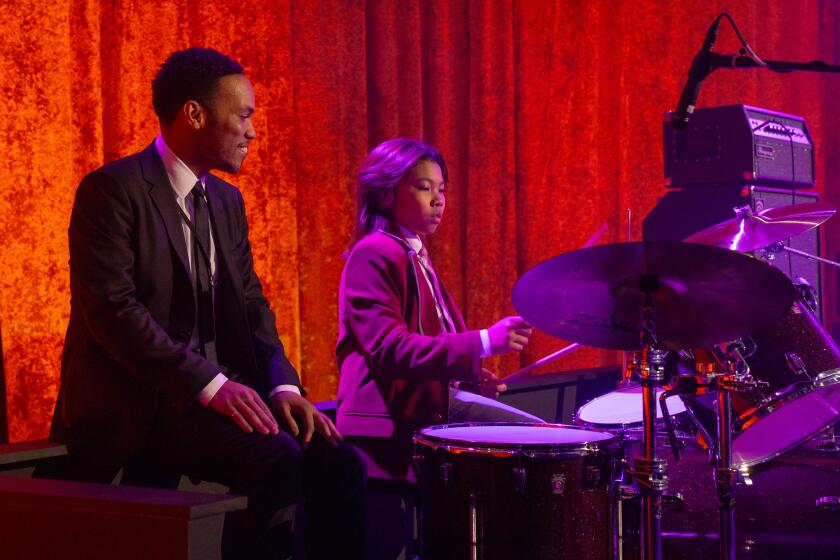Marc Lawrence, 95; Prolific Actor Best Known for Playing Menacing Characters in Movies
With his piercing eyes, pockmarked face and brooding air, Bronx-born character actor Marc Lawrence portrayed a memorable array of menacing gangsters over seven decades.
In 1935, he played Lefty Croger, a gang henchman in the Paul Muni crime drama “Dr. Socrates.”
In 1948, he played Ziggy, Edward G. Robinson’s fedora-wearing fellow mobster who shows up during a lull in the storm to buy a shipment of counterfeit money in “Key Largo.”
In 1971, he appeared as one of the three black-suited Slumber Inc. henchmen who tossed Plenty O’Toole (Lana Wood) through a high-rise hotel window into a pool in the James Bond classic “Diamonds Are Forever.”
Looking out of the window afterward, Sean Connery as Bond says, “Exceptionally fine shot.”
A deadpan Lawrence responds, “I didn’t know it was a pool down there.”
Lawrence, a stage-trained actor who fell victim to the Hollywood blacklist in the 1950s, died of natural causes Sunday at his home in Palm Springs, his family said. He was 95.
Beginning with an uncredited bit part as Gene Raymond’s cellmate in “If I Had a Million” in 1932, Lawrence appeared in more than 175 movies. Among them are “The Ox-Bow Incident,” “This Gun for Hire,” “Cloak and Dagger,” “The Asphalt Jungle,” “Marathon Man,” “Foul Play,” “The Man With the Golden Gun,” “The Big Easy” and “Ruby.”
In a notable change of pace, he delivered a touching performance as a mute hillbilly in the 1941 drama “The Shepherd of the Hills.”
But it was as a movie heavy that he made his mark, and more than 60 years after arriving in Hollywood, he was still being cast in such parts as mafia kingpin Carlo Gambino in HBO cable TV’s 1996 biographical drama “Gotti.”
“Lawrence belonged to that exclusive club of character players so good, so distinctive, that the minute he entered a scene, you knew exactly whom you were dealing with: In his case a baaaad egg cold enough to freeze Lowe’s State [theater] in a summer heat wave,” film historian and Turner Classic Movies host Robert Osborne wrote in the Hollywood Reporter in 1998.
Born Max Goldsmith, Lawrence began acting in New York. “I was the best actor in our school,” he told the Chicago Tribune in 1998. “I could memorize faster than anyone, and my old uncle in the Yiddish theater said I had stage guts, so I guess he inspired me.”
In 1930, after two years at City College of New York, Lawrence was accepted into Eva Le Gallienne’s renowned repertory theater, where he became friends with John Garfield. The two actors appeared on stage together in a number of plays, including Group Theatre productions.
By 1932, Lawrence had gone to Hollywood, where he played small roles in as many as 14 pictures in a single year (1939).
“I had this effect on people,” he told the Tribune. “I remember walking along the street and seeing Eddie Cantor’s name up on one of the theaters, so I stopped by the ticket seller and asked him, ‘When does Eddie go on?’ He looked at me and went pale and said, ‘You-you-you-you’re the guy in that picture up the street!’ He was petrified of me.
“So I went and watched that movie again and thought to myself, ‘Christ almighty, what an ugly [expletive]! Holes in my face, black eyes that pierce right through you. Here I thought I looked like Ronald Colman, and the ticket seller was right.”
After freelancing through half of the ‘30s, Lawrence signed with Columbia Pictures. “I made $150 a week working for [Columbia boss] Harry Cohn, who always liked me. He told me [mobster] Johnny Rosselli said I was the best hood in films.”
But the movie roles dried up in 1951 after two government agents knocked on the door of his North Hollywood home and accused him of being a Communist Party member.
“I got a subpoena,” Lawrence told the Riverside Press Enterprise in 1994. “That was tantamount to a guilty verdict. But, yeah, I was a member of the party. I joined about 1937. What ... did we know then? They passed out forms and said, ‘Sign your name for hope and humanity.’ I was all for hope and humanity, so I signed my name.
“I went to about five or six meetings. When I got bored at home I’d go to a meeting. That’s just about it as far as I was concerned.”
Pressured by the House Un-American Activities Committee, Lawrence admitted that he had been a member of the Communist Party and named other party members, something he felt guilty about for years. “I spoke against my own conscience,” he told the Tribune.
To escape the blacklist, Lawrence and his writer wife, Fanya Foss, moved to Italy in 1951 with their two children. Lawrence worked there as an actor in numerous films over the next eight years. He also returned to the stage, receiving critical acclaim for his portrayal of longshoreman Eddie Carbone in a 1958 London revival of Arthur Miller’s “A View From the Bridge.”
Returning to Hollywood in 1959, Lawrence began directing episodes of “Maverick,” “77 Sunset Strip” and other TV series.
In 1963, he was back on the big screen playing a deported mafia don in “Johnny Cool.” The next year, he directed, co-produced and co-wrote the low-budget film “Nightmare in the Sun,” starring John Derek and Ursula Andress. He later wrote, produced, directed and appeared in the 1972 thriller “Daddy’s Deadly Darling.”
Lawrence, who wrote a candid 1991 autobiography, “Long Time No See: Confessions of a Hollywood Gangster,” once said that “being a tough guy is easy. You just give them this hard look and yell, ‘Hey, you, get over here!’ and nobody bothers you.”
Lawrence’s wife of 53 years, Foss, died in 1995. He is survived by his second wife, Alicia; children Toni and Michael; and stepdaughter Marina Trevino.
More to Read
Only good movies
Get the Indie Focus newsletter, Mark Olsen's weekly guide to the world of cinema.
You may occasionally receive promotional content from the Los Angeles Times.










